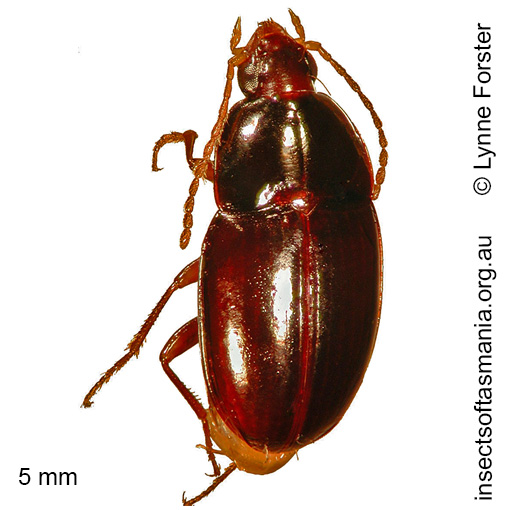
Sloaneana tasmaniae (Sloane, 1915) (a species of ground-beetle)
Basis for Tasmanian occurrence
Classification
Suborder: Adephaga
Superfamily: Caraboidea
Family: Carabidae
Subfamily: Trechinae
Tribe: Zolini
Morphology
Flightedness: winged and assumed capable of flight
Source literature on morphology and taxonomy (*primary taxonomic source, where identified):
Moore, B.P. (1972). A revision of the Australian Trechinae (Coleoptera: Carabidae). Aust. J. Zool. Suppl. Series 18: 1–61.
*Sloane, T.G. (1920). The Carabidae of Tasmania. Proc. Linn. Soc. NSW 45: 113-178.
Ecology
Association with dead wood or old trees: at least facultatively saproxylic
Ecological attributes: — Able to recolonise regrowth (Taylor & Doran, 2001) — Active primarily in winter-early spring (Michaels & McQuillan, 1995) — Affiliated with intermediate-aged (ex-clearfelled) forest (Michaels, 1999) — Affiliated with mature (unlogged) forest (Grove, 2009) — Affiliated with mature (unlogged) forest (Michaels, 1999) — Dry sclerophyll forest can be suitable habitat (Michaels, 1999b) — May occupy logs or trunks of Eucalyptus obliqua, at least temporarily, since found having emerged within six years of felling (Grove et al., 2009).
Collection method(s) for TMAG material: — Emergence trapping from cut billets of Eucalyptus obliqua (Harrison, 2007) — Emergence trapping from log of Eucalyptus obliqua — Flight intercept trapping (trough below Malaise trap) — Hand collection (substrate not specified) — Hand collection from leaf litter — Malaise trapping — Pitfall trapping — Trunk window trapping (Harrison, 2007).
Source ecological literature:
Grove, S.J. (2009b). Beetles and fuelwood harvesting: a retrospective study from Tasmania’s southern forests. Tasforests 18: 77-99.
Baker, S.C. (2000). Forest litter beetles and their habitat: a comparison of forest regenerated by wildfire and logging practices. Hons. thesis, Univ. of Tasmania, Hobart.
Baker, S.C. (2006b). Ecology and conservation of ground-dwelling beetles in managed wet eucalypt forest: edge and riparian effects. PhD thesis, Univ. of Tasmania, Hobart.
Grove, S. et al. (2009). A long-term experimental study of saproxylic beetle … succession in Tasmanian Eucalyptus … logs… In: Fattorini, S. (Ed.), Insect Ecology and Conservation. Research Signpost, pp. 71-114.
Grove, S.J. & Yaxley, B. (2005). Wildlife habitat strips and native forest ground-active beetle assemblages in plantation nodes in northeast Tasmania. Aust. J. Entom. 44 (4): 331-343.
Grove, S.J. (2009c). Do wildlife habitat strips act as refuges for mature-forest carabid beetle assemblages? A case-study in Tasmanian wet eucalypt forest, Australia. For. Ecol. Manage. 259: 496-504.
Harrison, K.S. (2007). Saproxylic beetles associated with habitat features in Eucalyptus obliqua trees in the southern forests of Tasmania. PhD thesis, Dept. of Zoology, Univ. of Tasmania, Hobart.
Jones, N.M. (2007). Tree fern invertebrates: variation of invertebrate assemblages on the tree fern Dicksonia antarctica and its quarantine applications. Hons. thesis, Univ. of Tasmania, Hobart.
Michaels, K.F. & McQuillan, P.B. (1995). Impact of commercial forest management on geophilous Carabid beetles (Coleoptera; Carabidae) in tall, wet Eucalyptus obliqua forest in southern Tasmania. Aust. J. Ecol. 20: 316-323.
Michaels, K.F. (1999a). Carabid beetles as biodiversity and ecological indicators. PhD thesis, Univ. of Tasmania, Hobart.
Michaels, K.F. (1999b). Carabid … communities in Tasmania: classification for nature conservation. In: Ponder, W. & Lunney, D. (Ed.), The Other 99%: …. Roy. Zool. Soc. NSW, pp. 374-379.
Taylor, R.J. & Doran, N. (2001). Use of terrestrial invertebrates as indicators of the ecological sustainability of forest management under the Montreal Process. J. Insect Cons. 5: 221-231.
Taylor, R.J. et al. (2000). Occurrence of old-growth carabid beetles in retained unlogged strips in … southern Tasmania. In: Saunders, D. et al. . (Eds.), Nature Conservation 5…. Surrey Beatty, pp. 120-127.
Yee, M. (2005). The ecology and habitat requirements of saproxylic beetles native to Tasmanian wet eucalypt forests: potential impacts of commercial forestry practices. PhD thesis, Univ. of Tasmania, Hobart.
Yee, M. et al. (2006). Brown rot in inner heartwood: why large logs support characteristic … beetle assemblages … In Grove, S.J. & Hanula, J.L. (eds.) Insect biodiv. and dead wood, pages 42-56. USDA For. Serv., SRS.Surrey Beatty, pp. 120-127.

